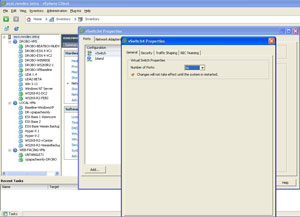Religious Issue #8: vSwitch Default Port Quantities
In a few circles in the virtualization community, some experts recommend stepping down the number of ports for virtual switches (vSwitch) in VMware vSphere, as well as VI3 installations. This was also evident in
a post last year where higher consolidation ratios may drive vSphere administrators to up the amount of ports on a vSwitch.
For VI3, a standard vSwitch has 56 ports assigned by default. From there, all of the guest virtual machines connect via their assigned port groups to that switch and decrement the port count one for one as the VMs have virtual network interfaces assigned. For vSphere, the default value stayed at 56 ports for a standard vSwitch but the new distributed virtual switch feature changes things a bit. Fig. 1 shows the default configuration for a standard vSwitch.
 |
| Figure 1. The default configuration can be changed from 8 to 4088 ports on a standard vSwitch. (Click image to view larger version.) |
When the distributed virtual switch is used, additional configuration points as well as a higher default number of ports come into play. For the distributed virtual switch, a port group is assigned 128 ports by default.
In my virtualization practice for server consolidation, I’ve only had to configure the default values upward once where the consolidation ration exceeded 56 virtual machines per host. I realized this only when a virtual switch was put into maintenance mode, and migrations started to fail. In a simple example of a four-host cluster with 169 virtual machines, the default value of 56 ports per vSwitch per host wasn't sufficient with only one vSwitch in use.
The other side of the coin is to downward provision ports and to be as explicit as possible. The shortcoming of this practice is that the available values may not align to the desired quantity depending on the technology used. Take the example of three sensitive systems in a security zone that will not have additional virtual machines without a documented change. The issue is that vSwitch port counts go as low as 8 ports instead of 3 when using a standard vSwitch. If the new distributed virtual switch is used, explicit quantities such as 3 can be used.
Each requirement is different, but I’m leaning toward provisioning upward to avoid the stopping point that I hit once on a standard vSwitch. For distributed virtual switching, this can be complicated for larger clusters. I’ll take a play from storage practices to build it wide from the start and recommend creating a higher than default value for ports available for each distributed switch port group.
Posted by Rick Vanover on 04/01/2010 at 12:47 PM